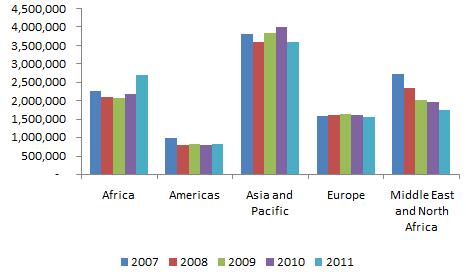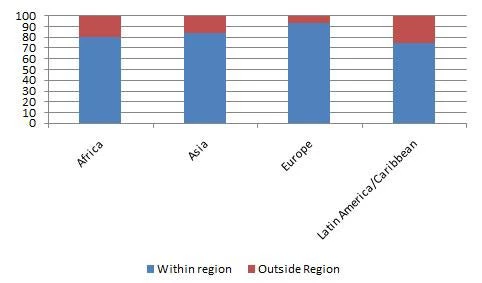The UN High Commission for Refugees (UNHCR) launched its 2011 Global Trends report on refugees, stateless persons and internally displaced persons shortly in advance of World Refugee Day on July 20. Bearing the subtitle of a "year of crises", the report documents that conflicts in Africa contributed to the emergence of over 800,000 refugees last year. This is the highest number in over ten years.
Fig 1. Refugee levels fell in most region save for a big increase in Africa.
Refugee populations by UNHCR regions
Source: Complied from UNHCR Global Trends (various years). World Bank staff calculations.
Conflicts and violence in Ivory Coast, Libya and Somalia over the last couple of years reversed the trend of a decade in falling refugee levels in Africa. By the end of 2011, there were 2.7 million refugees in Africa, about 20 percent higher than at the start of the year. Global refugee levels rose as the increases in Africa offset big declines in refugee levels in other regions. Asia is the largest refugee host and saw a 10 percent decline over the last year as a result of revised estimates in the number of Afghans living in Iran and Pakistan along with some voluntary repatriation of Afghans. Even with these declines this year, there are about as many Afghan refugees as there are refugees in Africa. The Middle East and North Africa also saw a 10 percent decline, partly driven by the return of many Libyans after the end of the civil war.
Almost all refugees move to neighboring countries in the same region. Only about 17 percent of refugees live outside their region of origin (Fig 2). The majority of refugee flows are South-South. The World Bank’s 2011 Migration and Remittances Factbook reported that the share of refugees in the migrant population was about 15 percent in low income countries and just over 2 percent in the OECD.
Fig 2. Almost all refugee flows are South-South
Percentage of refugees remaining within or outside their region of asylum.
Source: UNHCR Global Trends 2012.
These South-South refugee flows add to the developing challenges of some developing countries that may have limited capacity for absorbing and supporting them (Fig 3). About 45 percent of the world's refugees resided in countries with per capita incomes below $3,000 in purchasing power parity terms. The update reports the number of refugees as a portion of GDP per capita (PPP) and finds that the costs of absorbing refugees are high for some countries least able to afford them, particularly in Sub-Saharan Africa.
Fig 3. The costs of absording refugees are high for many low income economies. Total refugees to GDP per capita (USD PPP)
Source: UNHCR Global Trends 2012.



Join the Conversation